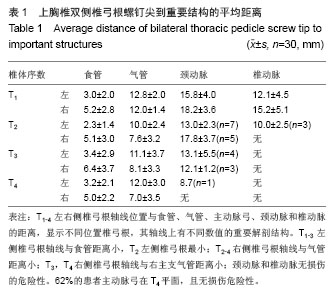| [1]Grossbach AJ, Dahdaleh NS, Abel TJ, et al. Flexion- distraction injuries of the thoracolumbar spine: open fusion versus percutaneous pedicle screw fixation. Neurosurg Focus. 2013 ;35(2):E2.
[2]Kulik G, Pralong E, McManus J, et al. A CT-based study investigating the relationship between pedicle screw placement and stimulation threshold of compound muscle action potentials measured by intraoperative neurophysiological monitoring. Eur Spine J. 2013;22(9): 2062-2068.
[3]Hwang SW, Samdani AF, Stanton P, et al. Impact of pedicle screw fixation on loss of deformity correction in patients with adolescent idiopathic scoliosis. J Pediatr Orthop. 2013;33(4): 377-382.
[4]Trobisch PD, Samdani AF, Betz RR, et al. Analysis of risk factors for loss of lumbar lordosis in patients who had surgical treatment with segmental instrumentation for adolescent idiopathic scoliosis. Eur Spine J. 2013;22(6):1312-1316.
[5]Akbar M, Dreher T, Schwab F, et al. Evaluation of the sagittal profile in patients with thoracic adolescent idiopathic scoliosis Lenke type 1 following posterior correction. Orthopade. 2013; 42(3):150-156.
[6]Allam Y, Silbermann J, Riese F, et al. Computer tomography assessment of pedicle screw placement in thoracic spine: comparison between free hand and a generic 3D-based navigation techniques. Eur Spine J. 2013;22(3):648-653.
[7]Bennett JT, Hoashi JS, Ames RJ, et al. The posterior pedicle screw construct: 5-year results for thoracolumbar and lumbar curves. J Neurosurg Spine. 2013;19(6):658-663.
[8]Gianaris TJ, Helbig GM, Horn EM. Percutaneous pedicle screw placement with computer-navigated mapping in place of Kirschner wires: clinical article. J Neurosurg Spine. 2013; 19(5):608-613.
[9]Grossbach AJ, Dahdaleh NS, Abel TJ, et al. Flexion-distraction injuries of the thoracolumbar spine: open fusion versus percutaneous pedicle screw fixation. Neurosurg Focus. 2013 ;35(2):E2.
[10]Lam FC, Groff MW, Alkalay RN. The effect of screw head design on rod derotation in the correction of thoracolumbar spinal deformity: laboratory investigation. J Neurosurg Spine. 2013 ;19(3):351-359.
[11]Paik H, Kang DG, Lehman RA Jr, et al. The biomechanical consequences of rod reduction on pedicle screws: should it be avoided? Spine J. 2013;13(11):1617-1626.
[12]Sugawara T, Higashiyama N, Kaneyama S, et al. Multistep pedicle screw insertion procedure with patient-specific lamina fit-and-lock templates for the thoracic spine: clinical article. J Neurosurg Spine. 2013;19(2):185-190.
[13]Kulik G, Pralong E, McManus J, et al. A CT-based study investigating the relationship between pedicle screw placement and stimulation threshold of compound muscle action potentials measured by intraoperative neurophysiological monitoring. Eur Spine J. 2013;22(9):2062-2068.
[14]Weaver J, Seipel S, Eubanks J. T1 intralaminar screws: an anatomic, morphologic study. Orthopedics. 2013;36(4): e473-477.
[15]Karapinar L, Erel N, Ozturk H, et al. Pedicle screw placement with a free hand technique in thoracolumbar spine: is it safe? J Spinal Disord Tech. 2008;21:63-67.
[16]Kim YJ, Lenke LG, Bridwell KH, et al. Free hand pedicle screw placement in the thoracic spine: is it safe? Spine. 2004; 29:333-342.
[17]Lehman RA, Polly DW, Kuklo TR, et al. Straight-forward versus anatomic trajectory technique of thoracic pedicle screw fixation: a biomechanical analysis. Spine.2003; 18: 2058-2065.
[18]Sarlak AY, Buluc L, Sarisoy HT, et al. Place of pedicle screws in thoracic idiopathic scoliosis: a magnetic resonance imaging analysis of screw placement relative to structures at risk. Eur Spine J. 2008;17: 657-662.
[19]Devkota P, Krishnakumar R, Renjith Kumar J. Surgical management of pyogenic discitis of lumbar region. Asian Spine J. 2014;8(2):177-182.
[20]Roy-Camille R, Saillant G, Mazel C. Internal fixation of the lumbar spine with pedicle screw plating.Clin Orthop Relat Res. 1986;203:7-17.
[21]Steffee AD, Biscup RS, Sitkowski DJ. Segmental spine plates with pedicle screw fixation. A new internal fixation device for disorders of the lumbar and thoracolumbar spine. Clin Orthop Relat Res. 1986;203:45-53.
[22]Mirza SK, Wiggins GC, Kuntz C 4th, et al. Accuracy of thoracic vertebral body screw placement using standard fluoroscopy, fluoroscopic image guidance, and computed tomographic image guidance: a cadaver study. Spine. 2003; 28(4):402-413.
[23]杨雷,李家顺. 经皮椎弓根螺钉技术的解剖学基础及其临床意义[J].中国临床解剖学杂志,2004,22(1):58-59.
[24]Sucato DJ, Duchene C. The position of the aorta relative to the spine: a comparison of patients with and without idiopathic scoliosis. J Bone Joint Surg Am. 2003;85:1461-1469.
[25]Kakkos SK, Shepard AD. Delayed presentation of aortic injury by pedicle screws: report of two cases and review of the literature. J Vasc Surg. 2008;47:1074-1082.
[26]Wegener B, Birkenmaier C, Fottner A, et al. Delayed perforation of the aorta by a thoracic pedicle screw. Eur Spine J. 2008;17(Suppl 2): S351-354.
[27]杨新文,王勇,杨开明.颈胸段脊柱椎体前方重要结构的解剖特点及其临床意义[J].中国临床解剖学杂志,2009,27(1):32-34.
[28]张烽,王素春,段广超,等. 颈胸段脊柱椎体周围重要脉管结构的应用解剖[J].中国临床解剖学杂志,2007,25(3):236-242.
[29]Kuklo TR, Lehman RA, Lenke LG. Structures at risk following anterior instrumented spinal fusion for thoracic adolescent idiopathic scoliosis. J Spinal Disord Tech. 2005;18(Suppl 1): S58-64.
[30]Carbone JJ,Tortolani PJ,Quartararo LG. Fluoroscopically as-sisted pedicle screw fixation for thoracic and thoracolumbar injuries:technique and short-term complications. Spine. 2003;28(1):91-97 .
[31]殷渠东,郑祖根,蔡建平.置入胸椎“椎弓根-肋骨”复合体螺钉的应用解剖和力学测试[J].中国临床解剖学杂志,2005, 23(5): 538-539.
[32]Suk S,Kim WJ,Lee SM,et al.Thoracic pedicle screws in spinal: Are they really safe.Spine. 2001;26(18):2049-2057.
[33]Husted DS, Haims AH, Fairchild TA, et al. Morphometric comparison of the pedicle rib unit to pedicle in the thoracic spine. Spine. 2004;29(2):139-146.
[34]White KK, Oka R, Mahar AT, et al. Pullout strength of thoracic pedicle screw instrumentation: comparison of the transpedicular and extrapedicular techniques.Spine,2006; 31(12):E355-358.
[35]崔新刚,张佐伦,陈海松,等. 胸椎椎弓根根外内固定的应用解剖学研究及其意义[J].中华创伤杂志, 2005,21(10):768-772.
[36]Carmignani A, Lentini S, Acri E, et al. Combined thoracic endovascular aortic repair and neurosurgical intervention for injury due to posterior spine surgery. J Card Surg. 2013;28(2): 163-167. |

